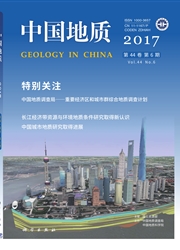

 中文摘要:
中文摘要:
西准噶尔包古图地区广泛发育富镁闪长质岩墙。对这些岩墙进行角闪石Ar-Ar和锆石U-Pb定年分别获得(313.1±3.5)Ma和(316.3±3.8)Ma的年龄,显示其主要形成于晚石炭世。闪长质岩墙以富Si(SiO2=56.8%-62.9%)、Mg(MgO=2.39%-4.04%、Mg#=54-62)、Cr(Cr=30×10-6-80×10-6)、Ni(Ni=20×10-6-62×10-6)为特征,具有弱的Eu负异常和高Sr/Y比值(36-44),强烈亏损HREE(Yb=1.32×10-6-1.54×10-6、Y=13.1×10-6-15.5×10-6),富集LILE(K、Sr、Ba),亏损HFSE(Nb、Ta、Ti)。这些特点显示,这些闪长质岩墙可能是由俯冲的板片熔体与地幔橄榄岩反应而成,与洋脊俯冲有关。而闪长质岩墙的形成过程也有利于铜金矿床的形成,显示该区有良好的成矿远景。
 英文摘要:
英文摘要:
The magnesian dioritic dykes widely distributed in west Junggar of Xinjiang recorded the Late Paleozoic tectonic evolutionary history of the area.The LA-ICP-MS zircon U-Pb and amphibole Ar-Ar dating of dioritic dykes yielded a 206 Pb/ 238 U age of 316.3±3.8 Ma and a plateau age of 313.1±3.5 Ma,respectively,suggesting that they were generated in Late Carboniferous.The magnesian dioritic dikes(56.8%-62.9%) are characterized by high MgO(2.39%-4.04%;Mg # = 54-62),Cr(30×10-6-80 ×10-6),and Ni(20×10-6-62×10-6) content.These samples show negligible to negative Eu values,high Sr/Y(36-44) ratios,strong depletion of HREE(e.g.,Yb = 1.32×10-6-1.54×10-6 and Y=13.1×10-6-15.5×10-6),and enrichment of large-ion-lithophile elements(LILE)(K,Sr,Ba) with negative Nb-Ta-Ti anomalies.These features are compatible with slab-derived adakites interacted with mantle materials and related to ridge subduction.The interaction between high oxygen fugacity slab melt and mantle peridotite caused the decomposition of metal sulfides and the Cu and Au mineralization.Baogutu area of west Junggar thus has good metallogenic prospect.
 同期刊论文项目
同期刊论文项目
 同项目期刊论文
同项目期刊论文
 Petrogenesis of Early Carboniferous adakitic dikes, Sawur region, northern West Junggar, NW China: i
Petrogenesis of Early Carboniferous adakitic dikes, Sawur region, northern West Junggar, NW China: i 期刊信息
期刊信息
